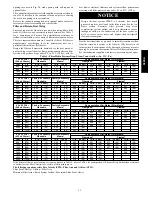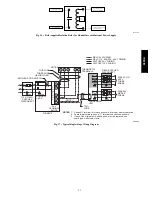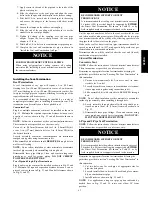
32
GAS PIPING
FIRE OR EXPLOSION HAZARD
Failure to follow this warning could result in personal
injury, death, and/or property damage.
Never purge a gas line into a combustion chamber. Never
test for gas leaks with an open flame. Use a commercially
available soap solution made specifically for the detection
of leaks to check all connections. A fire or explosion may
result causing property damage, personal injury or loss of
life.
!
WARNING
FIRE OR EXPLOSION HAZARD
Failure to follow this warning could result in personal
injury, death, and/or property damage.
Use proper length of pipe to avoid stress on gas control
manifold and gas valve.
!
WARNING
FIRE OR EXPLOSION HAZARD
Failure to follow this warning could result in personal
injury, death, and/or property damage.
Gas valve inlet and/or inlet pipe must remain capped until
gas supply line is permanently installed to protect the valve
from moisture and debris. Also, install a sediment trap in the
gas supply piping at the inlet to the gas valve.
!
WARNING
Gas piping must be installed in accordance with national and local
codes. Refer to current edition of NFGC in the U.S.A. Refer to
current edition of NSCNGPIC in Canada.
Installations must be made in accordance with all authorities
having jurisdiction. If possible, the gas supply line should be a
separate line running directly from meter to furnace.
NOTE
: Use a back--up wrench on the inlet of the gas valve when
connecting the gas line to the gas valve.
In the state of Massachusetts:
1. Gas supply connections MUST be performed by a licensed
plumber or gas fitter.
2. When flexible connectors are used, the maximum length
shall not exceed 36 in. (915 mm).
3. When lever handle type manual equipment shutoff valves
are used, they shall be T--handle valves.
4. The use of copper tubing for gas piping is NOT approved
by the state of Massachusetts.
NOTICE
Refer to Table 10 for recommended gas pipe sizing. Risers must be
used to connect to furnace and to meter. Support all gas piping
with appropriate straps, hangers, etc. Use a minimum of one hanger
every 6 ft. (2 M). Joint compound (pipe dope) should be applied
sparingly and only to male threads of joints. Pipe dope must be
resistant to the action of propane gas.
FIRE OR EXPLOSION HAZARD
A failure to follow this warning could result in personal
injury, death, and/or property damage.
If local codes allow the use of a flexible gas appliance
connector, always use a new listed connector. Do not use a
connector which has previously served another gas
appliance. Black iron pipe shall be installed at the furnace
gas control valve and extend a minimum of 2--in. (51 mm)
outside the furnace.
!
WARNING
FURNACE DAMAGE HAZARD
Failure to follow this caution may result in furnace damage.
Connect gas pipe to furnace using a backup wrench to
avoid damaging gas controls and burner misalignment.
CAUTION
!
An accessible manual equipment shutoff valve MUST be installed
external to furnace casing and within 6 ft. (2 M) of furnace.
Install a sediment trap externally in the riser leading to furnace as
shown in Fig. 33. Connect a capped nipple into lower end of tee.
Capped nipple should extend below level of furnace gas controls.
Place a ground joint union between furnace gas control valve and
exterior manual equipment gas shutoff valve.
A 1/8--in. (3 mm) NPT plugged tapping, accessible for test gauge
connection, MUST be installed immediately upstream of gas
supply connection to furnace and downstream of manual
equipment shutoff valve.
Piping should be pressure and leak tested in accordance with the
current addition of the NFGC in the United States, local, and
national plumbing and gas codes before the furnace has been
connected. Refer to current edition of NSCNGPIC in Canada.
After all connections have been made, purge lines and check for
leakage at furnace prior to operating furnace.
NOTE
:
The furnace gas control valve inlet pressure tap
connection is suitable to use as test gauge connection providing
test pressure DOES NOT exceed maximum 0.5 psig (14--in. w.c.)
stated on gas control valve. See Fig. 59.
If pressure exceeds 0.5 psig (14--in. w.c.), gas supply pipe must be
disconnected from furnace and capped before and during supply
pipe pressure test. If test pressure is equal to or less than 0.5 psig
(14--in. w.c.), turn off electric shutoff switch located on furnace gas
control valve and accessible manual equipment shutoff valve
before and during supply pipe pressure test. After all connections
have been made, purge lines and check for leakage at furnace prior
to operating furnace.
The gas supply pressure shall be within the maximum and
minimum inlet supply pressures marked on the rating plate with
the furnace burners ON and OFF.
Gas entry can be from left or right side, or top panel. See Figs. 31
and 32.
Gas Pipe Grommet
For direct vent (2-pipe) applications, the knockout for the gas pipe
must be sealed to prevent air leakage. Remove the knockout, install
the grommet in the knockout, then insert the gas pipe. The
grommet is included in the loose parts bag. See Fig. 31.
922SA
















































